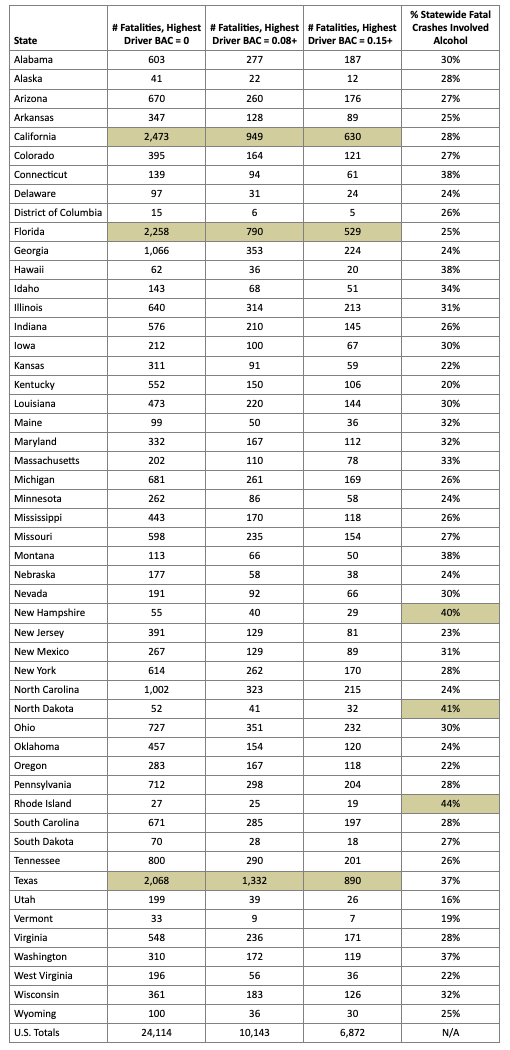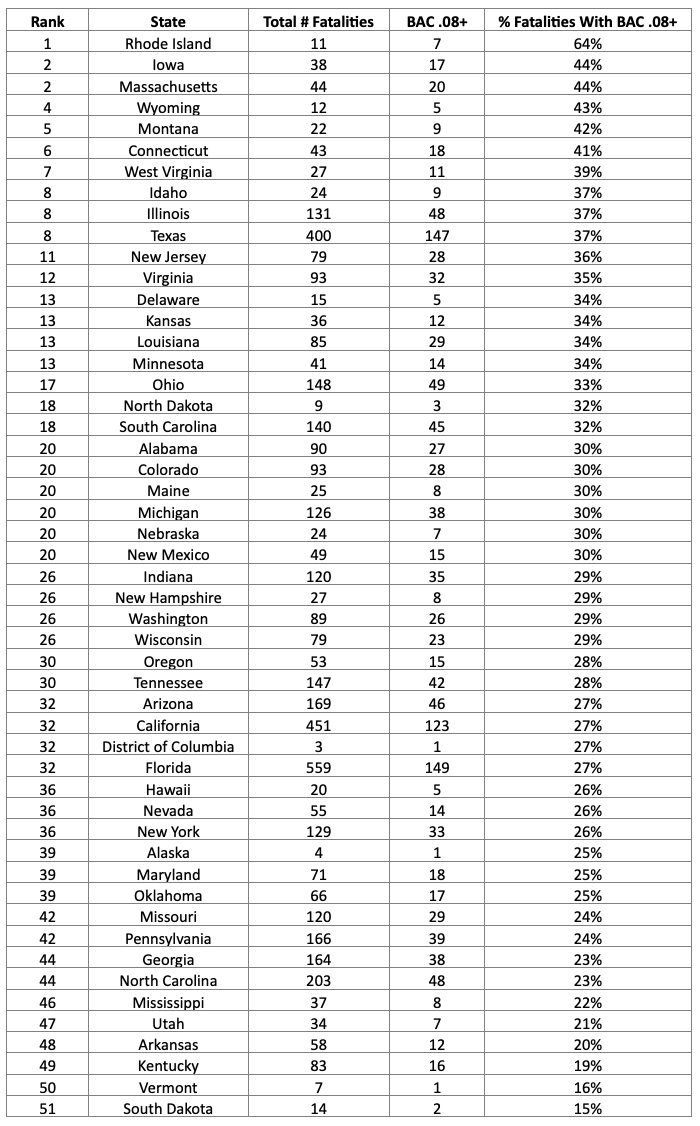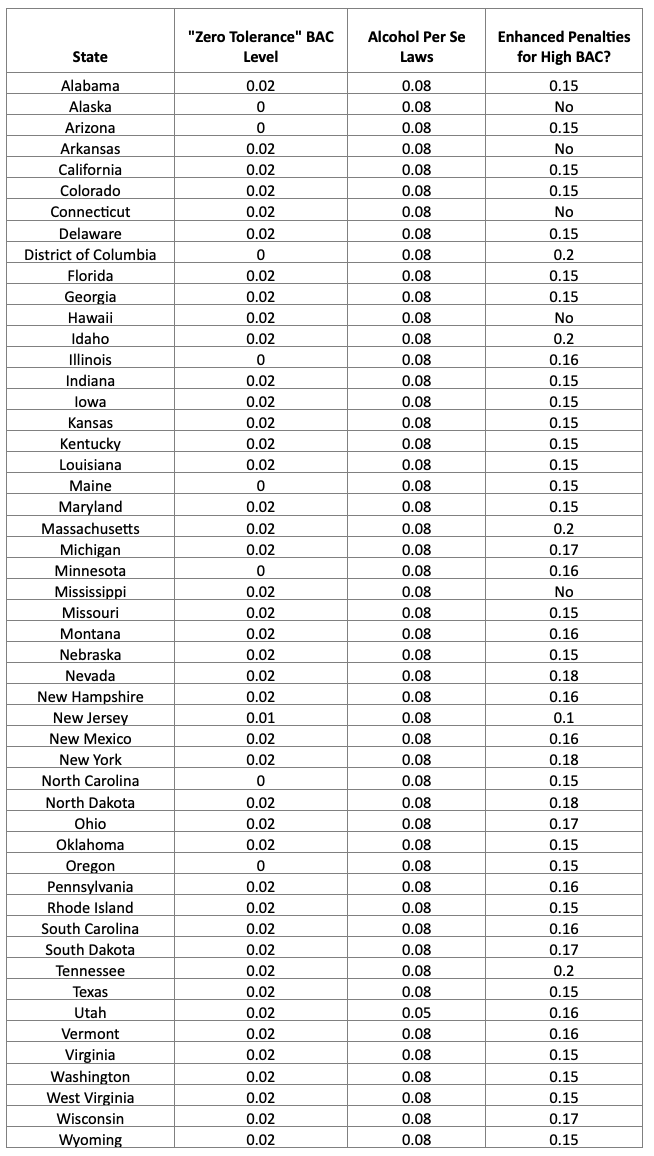Across all 50 states, minors under the age of 21 are held to incredibly strict standards when it comes to alcohol consumption and driving impaired.
Every year, countless lives are impacted by traffic collisions caused by impaired drivers. Driving under the influence (or DUI) can cause lifelong consequences for the impaired driver, other motorists, bikers, and even pedestrians. In 2020, the United States experienced an estimated 38,680 collision-related fatalities, according to data provided by Mothers Against Drunk Driving (MADD). This figure comes out to roughly a 7% increase in motor vehicle deaths compared to the previous year.
The primary factors behind this spike in fatalities, despite reduced travel during the early days of the COVID-19 pandemic, were impaired driving, speeding, and failure to wear a seatbelt or age-appropriate restraint. In today’s article, we carefully examine both national DUI statistics and state-by-state laws and regulations prohibiting impaired driving. For our study, we primarily utilize National Highway Traffic Safety Administration (NHTSA) data from 2019, as state-by-state crash data from 2020 onward has not yet been made public.
Inspecting Fatal DUI Statistics by State
Using the NHTSA’s 2019 data, we charted the highest blood alcohol concentration (BAC) of all drivers involved in a unique collision, along with the percentage of each U.S. state’s fatal collisions involving alcohol. As an example, if there were two fatal injuries caused in a single-vehicle crash where the driver’s BAC was 0.17, both deaths would be marked under “# of Fatalities, Highest Driver BAC = 0.15+.”
Noteworthy findings:
- The three states with the highest percentages of alcohol-influenced collision fatalities were Rhode Island (44%), North Dakota (41%), and New Hampshire (40%)
- In two out of every five states, at least 30% of crash fatalities involved alcohol impairment
- In some order, Texas, Florida, and California had the highest number of traffic deaths in all three tracked BAC categories
- Although technically the District of Columbia is a territory and not a U.S. state, it had the least collision-related fatalities throughout 2019, at 26. The states of Vermont (49) and Rhode Island (71) experienced the next-fewest traffic deaths, even with Rhode Island leading all states in terms of alcohol-involved fatalities

Which States Have the Most Impaired Motorcyclist Accidents?
Recent research organized by Salter, Healy, Rivera & Heptner focuses specifically on motorcycle DUI statistics from 2019. Rhode Island again tops the list, leading all U.S. states in both the percentages of fatal motor vehicle and motorcycle deaths caused by alcohol impairment. Similarly, Texas, Florida, and California have the highest overall numbers of traffic-related deaths, including those where a motorcyclist was confirmed impaired at 0.08 BAC or higher.

DUI Laws & Regulations by State
All states (and the District of Columbia) have implemented strict laws designed to cut down on impaired driving and penalize those who endanger their own lives and others on the road. The standards for impairment and required penalties for a DUI vary by state, so we compiled data on each state’s key thresholds.
Our chart tracks each state’s:
Zero Tolerance BAC Level: Across all 50 states, minors under the age of 21 are held to incredibly strict standards when it comes to alcohol consumption and driving impaired. It is forbidden for minors to purchase or consume alcoholic beverages, which is reflected in “zero tolerance” DUI laws. A zero tolerance law sets the threshold for an underage DUI at a very low level, typically between 0 – 0.02%.
Alcohol Per Se Laws: The “per se” limit establishes that, once a driver reaches or exceeds the specified BAC, they are considered legally impaired in the eyes of the law. Currently, all states except Utah have set the per se threshold at 0.08%, while Utah adheres to a lower limit of 0.05%.
Enhanced Penalties for High BAC: In some states, committing a DUI at or beyond a specific BAC threshold may result in harsher penalties. This offense is sometimes referred to as an “aggravated DUI.” In states that differentiate between “DUI” and “aggravated DUI” (or the local equivalent), those charged with the latter may face a more serious charge or longer sentence. In our table, the corresponding column indicates 1) whether a state differentiates between high-BAC and regular DUIs and 2) if so, what the corresponding BAC threshold is.

Tracking Historical Trends – DUI Crash Statistics from 2016 – 2019
From 2016-2019, the U.S. experienced no less than 10,142 alcohol-related collision fatalities per year. Over the tracked four-year period, the country experienced an annual average of 10,506 alcohol-related traffic deaths. Alcohol-impaired drivers suffered the most casualties, with at least 6,370 annual fatalities per year in the given period.
Filing a Lawsuit Against an Impaired Motorist
If you suffered harm in a crash caused by an impaired driver, you may be contemplating a lawsuit against the responsible party. Remember that all personal injury cases are unique, and that it’s always important to speak to a local attorney that is familiar with DUI laws in the state where the accident occurred. Depending on where the accident occurred, your case may be subject to:
Pure negligence laws: In a state with established pure negligence laws, the injured party may likely sue an impaired driver for harm sustained. As with other personal injury cases, you will need to prove that the other driver(s) owed you a duty of care and breached that responsibility by driving impaired and harming you or destroying your property.
No-fault laws: In a no-fault state, a threshold is implemented to prevent personal injury lawsuits unless the plaintiff’s damages exceed a certain value or reach a defined level of severity. If you suffered minor property damage or injuries, it is unlikely that you would be able to successfully file suit against the impaired driver. Instead, you would likely need to go through insurance to recover compensation.
Wrongful death statutes: If you’ve lost a loved one to a drunk or otherwise impaired motorist, you may be able to sue the responsible driver for wrongful death. Depending on the situation, your attorney may be able to seek non-economic, economic, and punitive damages.
Works Cited:
https://cdan.nhtsa.gov/tsftables/tsfar.htm
https://www.salterhealy.com/florida-motorcycle-accident-statistics/


Join the conversation!